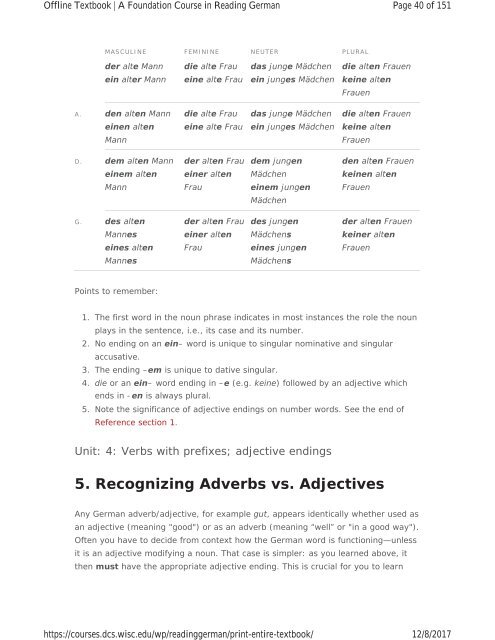A Foundation Course in Reading German, 2017a
A Foundation Course in Reading German, 2017a
A Foundation Course in Reading German, 2017a
You also want an ePaper? Increase the reach of your titles
YUMPU automatically turns print PDFs into web optimized ePapers that Google loves.
Offl<strong>in</strong>e Textbook | A <strong>Foundation</strong> <strong>Course</strong> <strong>in</strong> Read<strong>in</strong>g <strong>German</strong><br />
https://courses.dcs.wisc.edu/wp/read<strong>in</strong>ggerman/pr<strong>in</strong>t-entire-textbook/<br />
Page 40 of 151<br />
12/8/2017<br />
MASCULINE FEMININE NEUTER PLURAL<br />
der alte Mann<br />
die alte Frau<br />
das junge Mädchen<br />
die alten Frauen<br />
e<strong>in</strong> alter Mann<br />
e<strong>in</strong>e alte Frau<br />
e<strong>in</strong> junges Mädchen<br />
ke<strong>in</strong>e alten<br />
Frauen<br />
A. den alten Mann<br />
die alte Frau<br />
das junge Mädchen<br />
die alten Frauen<br />
e<strong>in</strong>en alten<br />
e<strong>in</strong>e alte Frau<br />
e<strong>in</strong> junges Mädchen<br />
ke<strong>in</strong>e alten<br />
Mann<br />
Frauen<br />
D. dem alten Mann<br />
der alten Frau<br />
dem jungen<br />
den alten Frauen<br />
e<strong>in</strong>em alten<br />
e<strong>in</strong>er alten<br />
Mädchen<br />
ke<strong>in</strong>en alten<br />
Mann<br />
Frau<br />
e<strong>in</strong>em jungen<br />
Frauen<br />
Mädchen<br />
G. des alten<br />
der alten Frau<br />
des jungen<br />
der alten Frauen<br />
Mannes<br />
e<strong>in</strong>er alten<br />
Mädchens<br />
ke<strong>in</strong>er alten<br />
e<strong>in</strong>es alten<br />
Frau<br />
e<strong>in</strong>es jungen<br />
Frauen<br />
Mannes<br />
Mädchens<br />
Po<strong>in</strong>ts to remember:<br />
1. The first word <strong>in</strong> the noun phrase <strong>in</strong>dicates <strong>in</strong> most <strong>in</strong>stances the role the noun<br />
plays <strong>in</strong> the sentence, i.e., its case and its number.<br />
2. No end<strong>in</strong>g on an e<strong>in</strong>– word is unique to s<strong>in</strong>gular nom<strong>in</strong>ative and s<strong>in</strong>gular<br />
accusative.<br />
3. The end<strong>in</strong>g –em is unique to dative s<strong>in</strong>gular.<br />
4. die or an e<strong>in</strong>– word end<strong>in</strong>g <strong>in</strong> –e (e.g. ke<strong>in</strong>e) followed by an adjective which<br />
ends <strong>in</strong> -en is always plural.<br />
5. Note the significance of adjective end<strong>in</strong>gs on number words. See the end of<br />
Reference section 1.<br />
Unit: 4: Verbs with prefixes; adjective end<strong>in</strong>gs<br />
5. Recogniz<strong>in</strong>g Adverbs vs. Adjectives<br />
Any <strong>German</strong> adverb/adjective, for example gut, appears identically whether used as<br />
an adjective (mean<strong>in</strong>g "good") or as an adverb (mean<strong>in</strong>g “well” or "<strong>in</strong> a good way").<br />
Often you have to decide from context how the <strong>German</strong> word is function<strong>in</strong>g—unless<br />
it is an adjective modify<strong>in</strong>g a noun. That case is simpler: as you learned above, it<br />
then must have the appropriate adjective end<strong>in</strong>g. This is crucial for you to learn


















